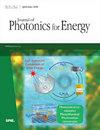Solar module orientation and tracking type performance and optimization
IF 2.1
4区 工程技术
Q4 MATERIALS SCIENCE, MULTIDISCIPLINARY
引用次数: 0
Abstract
Abstract. The efficiency and performance of solar cells and modules are typically evaluated and reported at normal incidence under peak solar radiation. We present a simple clear-sky model for solar irradiance that can be used to study the angular and annual performance of new photovoltaic materials. Using this model, we study the effect of solar module orientation for fixed-tilt module installations and different types of tracking (seasonal, 1D, and 2D) as a function of latitude. For fixed-tilt modules, the optimum tilt as a fraction of latitude varies from 0.83 at 1 deg to 0.73 at 60 deg. The effect of tilt misorientation for panels at the optimum azimuth is not very strong as the solar irradiance is about 94.5% of its optimum at ±20 deg mistilt. Both azimuth misorientation and tilt misorientation are studied. Optimized tilts and times of year for tilting are also obtained for modules that are seasonally adjusted twice and three times a year. The annual solar insolation of fixed modules is compared with modules that are seasonally adjusted twice and three times a year, continuously tracked in the north/south direction, continuously tracked in the east/west direction, and continuously tracked in two directions. The use of single-axis tracking in the east/west direction is preferable to north/south tracking and potentially improves overall energy collection by 16.2% to 31.0%. Continuous dual-axis tracking enhances overall annual energy collection by 36.0% to 45.5%. The model and provision of open source code provides for a way to assess the performance of new materials.太阳能组件定向和跟踪类型性能和优化
摘要太阳能电池和模块的效率和性能通常在峰值太阳辐射下的正入射下进行评估和报告。我们提出了一个简单的太阳辐照度晴朗天空模型,可用于研究新型光伏材料的角度和年度性能。使用该模型,我们研究了太阳能模块定向对固定倾斜模块安装和不同类型跟踪(季节性、1D和2D)的影响,作为纬度的函数。对于固定倾斜模块,作为纬度的一部分,最佳倾斜从1度时的0.83变化到60度时的0.73。在最佳方位角下,面板的倾斜定向误差影响不是很强,因为太阳辐照度约为±20时最佳值的94.5% 倾斜度。研究了方位角定向误差和倾斜度定向误差。对于每年进行两次和三次季节性调整的模块,还可以获得优化的倾斜和一年中的倾斜时间。固定模块的年太阳辐射量与每年两次和三次季节性调整、北/南方向连续跟踪、东/西方向连续跟踪和两个方向连续跟踪的模块进行比较。在东/西方向使用单轴跟踪比北/南跟踪更可取,并有可能将整体能源收集提高16.2%至31.0%。连续双轴跟踪可将整体年度能源收集提高36.0%至45.5%。该模型和开源代码的提供为评估新材料的性能提供了一种方法。
本文章由计算机程序翻译,如有差异,请以英文原文为准。
求助全文
约1分钟内获得全文
求助全文
来源期刊

Journal of Photonics for Energy
MATERIALS SCIENCE, MULTIDISCIPLINARY-OPTICS
CiteScore
3.20
自引率
5.90%
发文量
28
审稿时长
>12 weeks
期刊介绍:
The Journal of Photonics for Energy publishes peer-reviewed papers covering fundamental and applied research areas focused on the applications of photonics for renewable energy harvesting, conversion, storage, distribution, monitoring, consumption, and efficient usage.
 求助内容:
求助内容: 应助结果提醒方式:
应助结果提醒方式:


